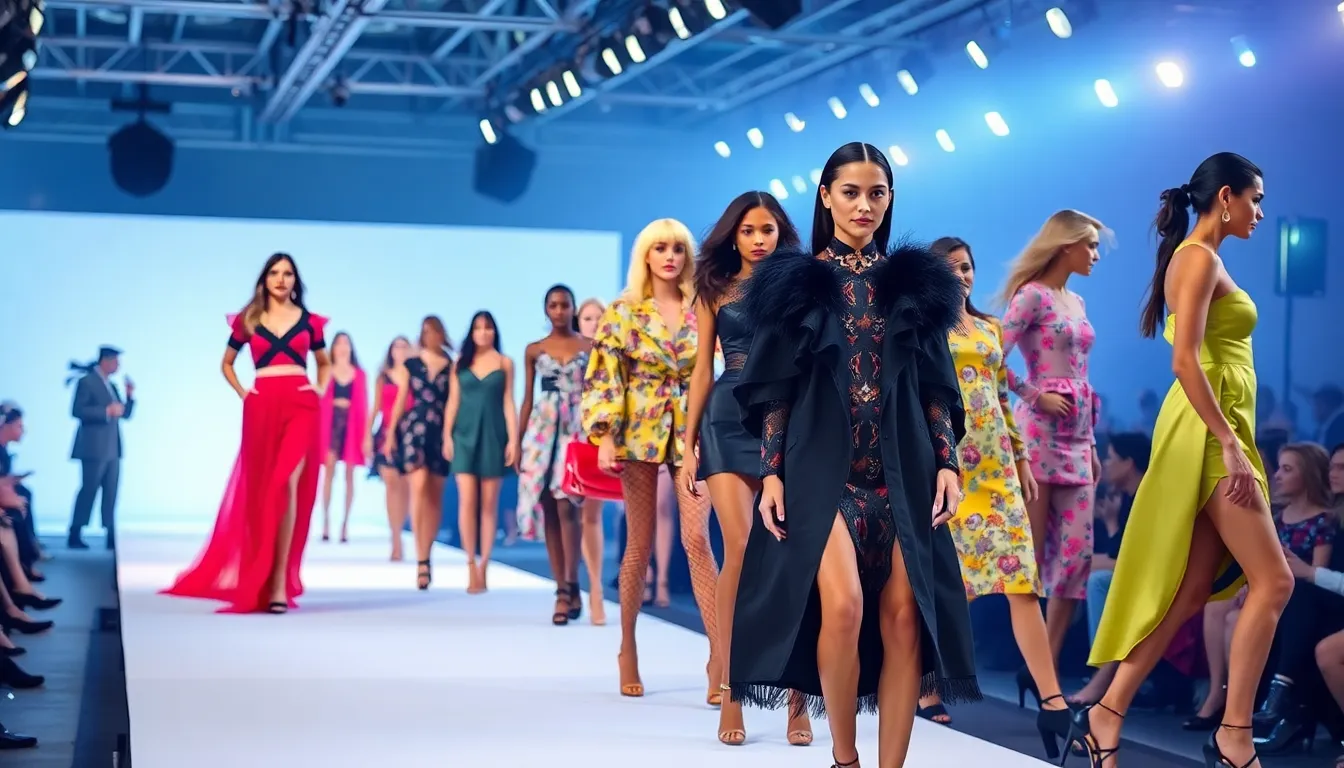In the ever-evolving world of fashion, collaborations between magazines and designers are like the unexpected twist in a plot twist—delightfully surprising and oh-so-stylish. Picture this: your favorite glossy magazine teaming up with a hotshot designer to create limited-edition pieces that make your wardrobe sing. It’s not just about clothes; it’s a fashion love story that captivates both the runway and the coffee table.
These partnerships spark creativity and ignite trends, proving that two minds (and a lot of fabric) are better than one. From exclusive interviews to behind-the-scenes access, readers get a front-row seat to the magic. So, buckle up as we dive into the dazzling world of fashion magazine collaborations, where style meets substance and every issue is a potential game-changer.
Table of Contents
ToggleOverview of Fashion Magazine Collaborations
Fashion magazine collaborations with designers often result in unique pieces that capture the essence of both partners. Limited-edition items frequently emerge from these partnerships, which enhance personal style and appeal to niche markets. Creativity thrives in these collaborations, offering fresh perspectives on fashion trends.
Magazines leverage their influence to innovate alongside established and emerging designers. Exclusive interviews and behind-the-scenes content provide insight into the collaborative process. This transparency helps consumers appreciate the artistry behind each piece.
Collaboration cases illustrate the resulting synergy between designers and magazines. Partners like Vogue and Gucci launched a capsule collection that showcased both brands’ aesthetics remarkably. Similarly, Harper’s Bazaar teamed with notable designers to curate stylish collections that reflect seasonal trends.
The impact of these collaborations extends beyond products, shaping discussions in the fashion industry. They set the tone for future trends, showing how strategic alliances can redefine fashion narratives. Creativity and commerce coexist within these partnerships and drive growth in the industry.
These initiatives not only create buzz but also foster community engagement among fashion enthusiasts. Events highlighting these collaborations often attract considerable attention and participation. Fans of both the magazines and designers gain the opportunity to explore these limited collections in person, further enhancing brand loyalty.
Fashion magazine collaborations not only enhance individual aesthetics but also propel the industry forward by intertwining editorial vision with design innovation.
Historical Context

Fashion magazine collaborations have a rich history, rooted in the dynamic interplay between print media and the fashion industry. Early partnerships laid the groundwork for contemporary creativity, merging editorial perspectives with designer visions.
Origin of Collaborations
Collaborations between fashion magazines and designers originated as a vehicle to showcase innovative styles. Publications like Vogue began pairing with prominent designers to unveil exclusive collections in the late 20th century. This early model enhanced brand visibility and shaped consumer trends, making the partnership mutually beneficial. For instance, the 1990s saw initiatives that combined the artistic direction of magazines with the flair of fashion houses, marking the start of a trend that would reshape the industry.
Evolution Over the Years
Over the years, collaborations have expanded beyond traditional boundaries. The 2000s experienced a surge in interest as magazines began partnering with emerging designers, showcasing fresh talent and redefining accessibility. Iconic partnerships emerged, such as the Vogue and Alexander Wang collaboration, which pushed creative limits. Today, collaborations often incorporate digital platforms, engaging a broader audience and creating a more interactive shopping experience. This evolution reflects not just changing aesthetics, but also shifts in consumer behavior and industry standards.
Notable Collaborations
Fashion magazine collaborations encompass a wide range of partnerships, from high-profile brands to underground designer collectives. These collaborations not only showcase creativity but also highlight the diversity within the fashion industry.
High-Profile Collaborations
Vogue has set the standard with its collaborations, notably with Gucci. This partnership produced a limited-edition capsule collection that quickly became iconic. Collaborations like this push both the brand and publication’s creative limits while appealing to fashion-forward audiences. Another example includes Harper’s Bazaar teaming up with renowned designers such as Alexander Wang and Christian Siriano, which resulted in exclusive pieces featured in editorial shoots. These high-profile collaborations continuously shape industry trends, enhancing brand recognition and customer loyalty.
Underground Collaborations
Emerging designers increasingly collaborate with fashion publications to gain visibility. For instance, magazines like Dazed collaborate with lesser-known talents, creating unique collections that celebrate individuality. These underground collaborations foster innovation by allowing designers to experiment with unconventional styles and materials. Additionally, smaller fashion magazines often highlight grassroots movements through partnerships with local artists, resulting in limited-edition items. Such collaborations enrich the fashion landscape by blending new voices with established platforms.
Impact on the Fashion Industry
Fashion magazine collaborations significantly shape the industry, driving trends and generating economic opportunities.
Influence on Trends
Collaborations often set new styles, influencing designers, retailers, and consumers. Designers gain exposure through partnerships, ensuring fresh ideas reach a broader audience. Seasonal collections reflect the unique aesthetics of both brand and publication, creating buzz around launches. For instance, Vogue and Gucci’s capsule collection not only showcased innovative designs but also set the tone for upcoming fashion seasons. Media coverage amplifies the impact, allowing trends to permeate mainstream fashion quickly. Niche markets enjoy tailored collections, resulting in a direct connection between creativity and consumer demand.
Economic Implications
Collaborations contribute to economic growth within the fashion sector. They’ve led to increased sales for both magazines and designers, fostering brand loyalty. Unique items often command higher prices, appealing to consumers who value exclusivity. Limited editions create urgency, driving demand and encouraging impulse purchases. Partnerships also attract sponsorships and advertising revenue, benefiting all parties involved. As collaborations expand, they support emerging designers, enhancing diversity and innovation in the market. In turn, established brands gain fresh insights from new voices, further enriching the industry landscape.
Future of Fashion Magazine Collaborations
Fashion magazine collaborations will increasingly reflect consumer preferences and technological advancements. These partnerships will reshape how brands connect with audiences, fostering interactive experiences that engage readers beyond traditional print mediums.
Emerging Trends
Emerging trends in fashion magazine collaborations emphasize sustainability and inclusivity. Brands partner with eco-conscious designers to create collections that prioritize ethical practices. Digital experiences gain traction, integrating augmented reality features that allow consumers to visualize garments in real-time. Magazines now highlight diverse voices, promoting underrepresented designers within features. Partnerships will shift towards experiential marketing, encouraging hands-on events that deepen consumer relationships. Ultimately, these collaborations will prioritize community input, ensuring that collections resonate with the target audience.
Predictions
Predictions suggest fashion magazine collaborations will become more global. Collaborations across continents will introduce unique cultural perspectives into mainstream fashion. Consumer-driven design processes may take center stage, enabling audiences to influence product direction. Trends will increasingly highlight local artisans, giving recognition to craftsmanship while supporting small businesses. By focusing on personalization, brands will create collections tailored to specific demographics. Innovations in technology, like blockchain, may ensure transparency and authenticity within partnerships. As this evolution unfolds, fashion magazine collaborations will drive the future landscape of fashion retail.
Fashion magazine collaborations are reshaping the industry in innovative ways. By merging editorial vision with designer creativity, these partnerships produce unique pieces that resonate with consumers. The evolution of these collaborations reflects a dynamic landscape where tradition meets modernity, enhancing brand visibility and driving trends.
As the industry embraces sustainability and inclusivity, future collaborations will likely incorporate diverse cultural perspectives and prioritize consumer engagement. This shift promises to create exciting opportunities for both established and emerging designers. The ongoing synergy between fashion magazines and designers will continue to influence personal style and redefine the fashion narrative.



